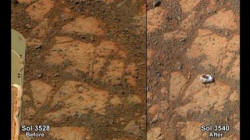 |
|

 Mystery
white rock inexplicably appears near NASA Mars rover
Mystery
white rock inexplicably appears near NASA Mars rover
[January 22, 2014] By Irene Klotz
CAPE CANAVERAL, Florida (Reuters) — Scientists are stumped as to how a rock mysteriously appeared in images taken two weeks apart by NASA's Mars rover Opportunity.
|
The rover, which landed in an area known as Meridiani Planum
a decade ago, is exploring the rim of a crater for signs of past
water. Another rover, Curiosity, touched down on the opposite side of
the planet in 2012 for a more ambitious mission to look for past
habitable environments. For the moment, however, scientists are pondering a more
immediate question. On January 8, while preparing to use its
robotic arm for science investigation, Opportunity sent back a
picture of its work area. Oddly, it showed a bright white rock, about the size of a
doughnut, where only barren bedrock had appeared in a picture
taken two weeks earlier. Scientists suspect the rock was flipped
over by one of the rover's wheels. It also may have been deposited after a meteorite landed nearby. Either way, the rock, dubbed "Pinnacle Island" is providing an
unexpected science bonus. "Much of the rock is bright-toned, nearly white," NASA said in a
statement on Tuesday. "A portion is deep red in color. Pinnacle
Island may have been flipped upside-down when a wheel dislodged
it, providing an unusual circumstance for examining the
underside of a Martian rock." (Editing by Kevin Gray and Eric Walsh) [© 2014 Thomson Reuters. All rights reserved.] Copyright 2014 Reuters. All rights reserved. This material may not be published,
broadcast, rewritten or redistributed.
|


